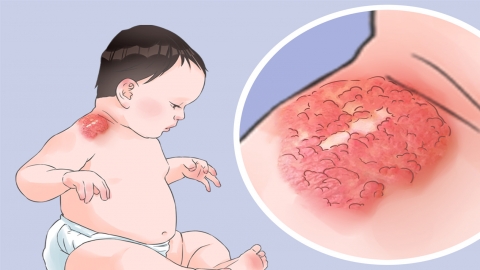What are the symptoms of hemangioma on an infant's head?
In general, the main symptoms of infantile hemangioma on the head include abnormal skin coloration, raised skin masses, color changes upon pressure, changes associated with growth and development, and occasional ulceration or bleeding. If any of these symptoms are observed, it is recommended to promptly take the infant to a reputable medical facility for evaluation and diagnosis. The details are as follows:
1. Abnormal Local Skin Color
Infantile hemangiomas on the head often present as localized changes in skin color, commonly appearing red, purplish-red, or bluish. Redness typically results from dense proliferation of superficial capillaries with abundant blood flow; a bluish tint usually indicates deeper vascular dilation, where the blood color shows through the skin. The shade may vary depending on the type and depth of the hemangioma.

2. Raised Skin Mass
Some hemangiomas on an infant's head protrude from the skin surface, forming soft, raised lumps. These masses have a spongy texture, are generally painless upon touch, may temporarily deform when pressed, and return to their original shape after pressure is released. Their size can range from a few millimeters to several centimeters, and some may change gradually as the infant grows.
3. Color Change Upon Pressure
When gently pressing on the hemangioma site, the skin color will noticeably fade or even temporarily disappear. After releasing the pressure, the color gradually returns. This occurs because blood is temporarily displaced from the hemangioma during compression and refills afterward. This characteristic helps differentiate hemangiomas from other types of skin lesions.
4. Changes With Growth and Development
Within the first few months after birth, hemangiomas on the head may enter a rapid growth phase, characterized by darkening color and increasing size. Afterwards, some hemangiomas transition into a stable phase with slowed growth. A minority may begin to regress after the age of one year, showing lighter color and reduced size over time.
5. Occasional Ulceration and Bleeding
If a hemangioma is located in an area of the head prone to friction, or if the infant scratches it or experiences external trauma, ulceration and bleeding may occur. This typically manifests as skin breakdown and oozing blood, usually in small amounts. Prompt care is necessary to prevent infection, and minor scarring may remain after healing.
In daily care, it is important to keep the skin over the hemangioma clean and dry, avoiding rubbing with coarse towels. Dressing the infant in soft hats can help reduce the risk of external trauma. If the hemangioma rapidly increases in size within a short period, frequently ulcerates or bleeds, or shows signs of redness, swelling, or infection, prompt medical attention is advised. A physician should evaluate whether intervention or treatment is necessary.







